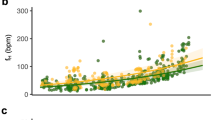Abstract
Previous studies have suggested that Australian long-eared bats (Nyctophilus) differ from northern-hemisphere bats with respect to their thermal physiology and patterns of torpor. To determine whether this is a general trait of Australian bats, we characterised the temporal organisation of torpor and quantified metabolic rates and body temperatures of normothermic and torpid Australian bats (Nyctophilus geoffroyi, 7 g and N. gouldi, 10 g) over a range of air temperatures and in different seasons. The basal metabolic rate of normothermic bats was 1.36 ± 0.17 ml g−1 h−1 (N. geoffroyi) and 1.22 ± 0.13 ml g−1 h−1 (N. gouldi), about 65% of that predicted by allometric equations, and the corresponding body temperature was about 36 °C. Below an air temperature of about 25 °C bats usually remained normothermic for only brief periods and typically entered torpor. Arousal from torpor usually occurred shortly after the beginning of the dark phase and torpor re-entry occurred almost always during the dark phase after normothermic periods of only 111 ± 48 min (N. geoffroyi) and 115 ± 66 min (N. gouldi). At air temperatures below 10 °C, bats remained torpid for more than 1 day. Bats that were measured overnight had steady-state torpor metabolic rates representing only 2.7% (N. geoffroyi) and 4.2% (N. gouldi) of the basal metabolic rate, and their body temperatures fell to minima of 1.4 and 2.3 °C, respectively. In contrast, bats measured entirely during the day, as in previous studies, had torpor metabolic rates that were up to ten times higher than those measured overnight. The steady-state torpor metabolic rate of thermoconforming torpid bats showed an exponential relationship with body temperature (r 2 = 0.94), suggesting that temperature effects are important for reduction of metabolic rate below basal levels. However, the 75% reduction of metabolic rate between basal metabolic rate and torpor metabolic rate at a body temperature of 29.3 °C suggests that metabolic inhibition also plays an important role. Torpor metabolic rate showed little or no seasonal change. Our study suggests that Australian Nyctophilus bats have a low basal metabolic rate and that their patterns of torpor are similar to those measured in bats from the northern hemisphere. The low basal metabolic rate and the high proclivity of these bats for using torpor suggest that they are constrained by limited energy availability and that heterothermy plays a key role in their natural biology.
Similar content being viewed by others
Author information
Authors and Affiliations
Additional information
Accepted: 22 November 1999
Rights and permissions
About this article
Cite this article
Geiser, F., Brigham, R. Torpor, thermal biology, and energetics in Australian long-eared bats (Nyctophilus). J Comp Physiol B 170, 153–162 (2000). https://doi.org/10.1007/s003600050270
Issue Date:
DOI: https://doi.org/10.1007/s003600050270




